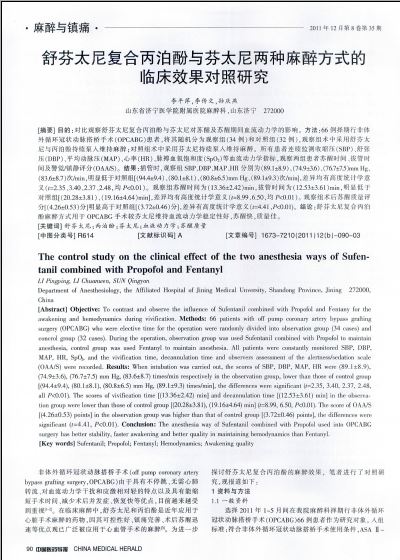舒芬太尼复合丙泊酚与芬太尼两种麻醉方式的临床效果对照研究(1)
 |
| 第1页 |
参见附件。
[摘要] 目的:对比观察舒芬太尼复合丙泊酚与芬太尼对苏醒及苏醒期间血流动力学的影响。方法:66例择期行非体外循环冠状动脉搭桥手术(OPCABG)患者,将其随机分为观察组(34例)和对照组(32例),观察组术中采用舒芬太尼与丙泊酚持续泵入维持麻醉;对照组术中采用芬太尼持续泵入维持麻醉。所有患者连续监测收缩压(SBP)、舒张压(DBP)、平均动脉压(MAP)、心率(HR)、脉搏血氧饱和度(SpO2)等血流动力学指标,观察两组患者苏醒时间、拔管时间及警觉/镇静评分(OAA/S)。结果:插管时,观察组SBP、DBP、MAP、HR分别为(89.1±8.9)、(74.9±3.6)、(76.7±7.5)mm Hg、(83.6±8.7)次/min,明显低于对照组[(94.4±9.4)、(80.1±8.1)、(80.8±6.5)mm Hg、(89.1±9.3)次/min],差异均有高度统计学意义(t=2.35、3.40、2.37、2.48,均P<0.01)。观察组苏醒时间为(13.36±2.42)min,拔管时间为(12.53±3.61)min,明显低于对照组[(20.28±3.81)、(19.16±4.64)min],差异均有高度统计学意义(t=8.99、6.50,均P<0.01)。观察组术后苏醒质量评分[(4.26±0.53)分]明显高于对照组[(3.72±0.46)分],差异有高度统计学意义(t=4.41,P<0.01)。结论:舒芬太尼复合丙泊酚麻醉方式用于OPCABG手术较芬太尼维持血流动力学稳定性好,苏醒快,质量佳。
[关键词] 舒芬太尼;丙泊酚;芬太尼;血液动力学;苏醒质量
[中图分类号] R614 [文献标识码] A [文章编号] 1673-7210(2011)12(b)-090-03
The control study on the clinical effect of the two anesthesia ways of Sufentanil combined with Propofol and Fentanyl
LI Pingping, LI Chuanwen, SUN Qingyan
Department of Anesthesiology, the Affiliated Hospital of Jining Medical Unversity, Shandong Province, Jining 272000, China
[Abstract] Objective: To contrast and observe the influence of Sufentanil combined with Propofol and Fentany for the awakening and hemodynamics during vivification. Methods: 66 patients with off pump coronary artery bypass grafting surgery (OPCABG) who were elective time for the operation were randomly divided into observation group (34 cases) and concrol group (32 cases). During the operation, observation group was used Sufentanil combined with Propofol to maintain anesthesia, control group was used Fentanyl to maintain anesthesia. All patients were constantly monitored SBP, DBP, MAP, HR, SpO2, and the vivification time, decannulation time and observers assessment of the alertness/sedation scale (OAA/S) were recorded. Results: When intubation was carried out, the scores of SBP, DBP, MAP, HR were (89 ......
您现在查看是摘要介绍页,详见PDF附件(2679kb)。